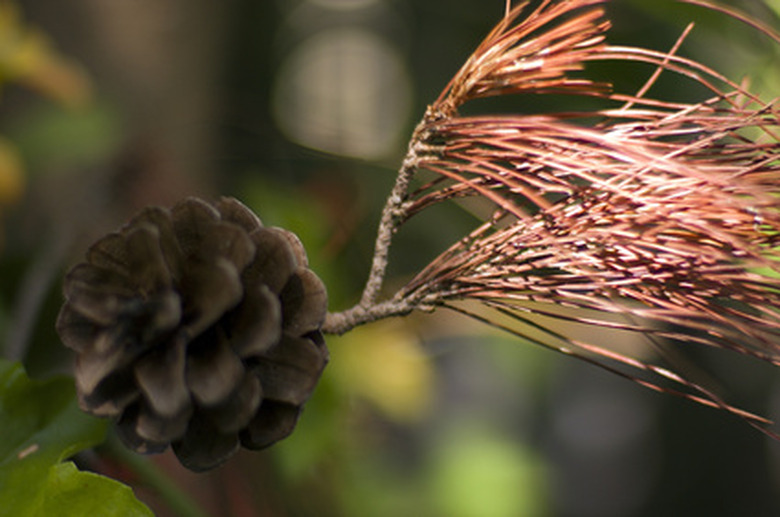Cedar Trees In Missouri
Missouri experiences a continental climate with hot summers and cold winters. The state of Missouri lies within United States Department of Agriculture (USDA) Hardiness zones 4 to 7. Missouri gardeners should choose cedar trees according to appropriate hardiness zone, needle color and mature size. Several types of cedar trees thrive in Missouri climates.
Red Cedar
The red cedar tree (Juniperus virginiana) naturally occurs in the fields, woods and glades of eastern North America. Red cedars feature a conical shape, gray bark and blue-green needles. The leaves sometimes take on a brown tone in the winter. Female red cedars bear round, dark green or gray cones that attract birds. Mature trees grow between 30 and 65 feet in height with spreads ranging from 8 to 25 feet. While red cedar trees prefer full sun positions in well-drained, medium moist soils, they can also tolerate some drought conditions. This cedar variety sometimes suffers from cedar apple rust, twig blight and bagworm infestations. Missouri gardeners often use red cedar trees to form large property screens.
- Missouri experiences a continental climate with hot summers and cold winters.
- The red cedar tree (Juniperus virginiana) naturally occurs in the fields, woods and glades of eastern North America.
Western Red Cedar
Western red cedars (Thuja plicata) thrive in the cool, moist environment of the Pacific Northwest. Also called the giant red cedar, these trees reach heights up to 200 feet in the wild and up to 70 feet in gardens. This cedar variety likes well-drained soils in partially to fully sunny locations. Western red cedars bear light brown pinecones and aromatic, red-brown bark. The needle-like leaves stay dark green throughout the winter. Rots and bagworms are occasional problems. Missouri gardeners often prune down western red cedar trees to use as screens or hedges.
- Western red cedars (Thuja plicata) thrive in the cool, moist environment of the Pacific Northwest.
- Western red cedars bear light brown pinecones and aromatic, red-brown bark.
Japanese Cedar
Japanese cedars (Cryptomeria japonica) prefer moist, well-drained soils in partly to fully sunny positions. Missouri gardeners should plant these cedars in sites that protect them from harsh winter weather. Mature trees reach up to 60 feet in height and 30 feet in width. Japanese cedars feature pyramidal forms, red-brown bark and fruiting cones. The sharp, bluish-green needles have a corkscrew shape. Japanese cedars sometimes suffer from leaf spot and leaf blight. This cedar variety works well as a specimen tree for larger lawns.
- Japanese cedars (Cryptomeria japonica) prefer moist, well-drained soils in partly to fully sunny positions.
- Japanese cedars feature pyramidal forms, red-brown bark and fruiting cones.
Cedar of Lebanon
Native to the mountains of Lebanon and Turkey, the cedar of Lebanon tree (Cedrus libani) is a cold-hardy variety that thrives in moist, loamy soils in full sun positions. This slow-growing cedar eventually reaches up to 60 feet in both height and spread. Cedar of Lebanon trees feature flat tops, barrel-like cones and clusters of deep green needles. Root rot and tip blight occasionally infect these cedars. Established cedar of Lebanon trees tolerate drought conditions. Missouri gardeners often use these cedars as landscape trees.
Incense Cedar
Incense cedar trees (Calocedrus decurrens) reach heights between 30 and 50 feet and spreads ranging from 8 to 10 feet. Native to the western United States, this cedar variety tolerates hot, humid summer weather. The incense cedar prefers well-drained, loamy soils in partly to fully sunny locations. Mature trees feature rounded crowns, red-brown bark and small pinecones. The green leaves release an incense-like fragrance when bruised or crushed. Rust and heart rot sometimes attack these trees. Incense cedars work well as hedges, screens and windbreaks.
- Native to the mountains of Lebanon and Turkey, the cedar of Lebanon tree (Cedrus libani) is a cold-hardy variety that thrives in moist, loamy soils in full sun positions.
- The green leaves release an incense-like fragrance when bruised or crushed.
